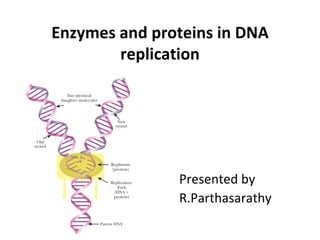
Enzymes and proteins in dna replication
- 1. Enzymes and proteins in DNA replication Presented by R.Parthasarathy
- 2. Introduction • Multiple proteins are required for DNA replication at a replication fork. • These include DNA polymerases, single-strand DNA binding proteins, helicases, primase,topoisomerases, and DNA ligase. Some of these are multisubunit protein complexes.
- 3. dnaA Protein • The base sequence at the origin of replication is recognized and bound by the dna A protein.
- 4. Helicase • Helicase uses energy from the ATP to break the hydrogen bonds holding the base pairs together. • This allows the two parental strands of DNA to begin unwinding and forms two replication forks. • Each strand of parental DNA has it own helicase. • In humans, two inherited diseases, Werner's syndrome and Bloom's syndrome, result from helicase defects. • E. coli contains at least 6 different helicases-- some involved in DNA repair and others in conjugation, the principal helicase in DNA replication is DnaB
- 5. SSB Protein • Single-stranded DNA binding protein (SSB) binds to the single-stranded portion of each DNA strand, preventing the strands from reassociating and protecting them from degradation by nucleases. • gp32, the most studied SSB protein, binds in a strongly cooperative fashion to single-strand DNA. • That is, binding adjacent to another gp32 is much more likely than the binding of a single gp32 in isolation. • This property helps promote the denaturation of duplex DNA and helps keep the DNA template in an extended, single-strand conformation, with the purine and pyrimidine bases exposed so that they can base-pair readily with incoming nucleotides. • In E. coli, the protein is called ssb. • In eukaryotic cells, a heterotrimeric protein called replication factor A serves the role of SSB in DNA replication.
- 6. Primase • Primase is an enzyme that copies a DNA template strand by making an RNA strand complementary to it. • Primase synthesizes a short (about 10 nucleotides) RNA primer in the 5’ 3’ direction. • The parental strand is used as a template for this process. • RNA primers are required because DNA polymerases are unable to initiate synthesis of DNA, but can only extend a strand from the 3' end of a preformed “primer” • The enzyme is active only in the presence of other proteins (including a helicase), which create a complex called the primosome
- 7. DNA polymerase III • It catalyzes the chemical reactions for polymerization of nucleotides. • DNA polymerase III begins synthesizing DNA in the 5’ 3’direction, beginning at the 3’ end of each RNA primer. • The newly synthesized strand is complementary and antiparallel to the parental strand used as a template.
- 8. DNA polymerase I • DNA polymerase I and RNAse H are involved in removing RNA primers in the processing of DNA after replication. • This enzyme removes the ribonucleotides one at a time from the 5' end of the primer (5‘ 3' exonuclease). • DNA polymerase I also fills in the resulting gaps by synthesizing DNA, beginning at the 3' end of the neighbouring Okazaki fragment. • Both DNA polymerase I and III have the ability to "proofread" their work by means of a 3' 5' exonuclease activity. • If DNA polymerase makes a mistake during DNA synthesis, the resulting unpaired base at the 3' end of the growing strand is removed before synthesis continues.
- 9. Comparison of DNA and RNA polymerases DNA Polymerase RNA Polymerase Nucleic acid synthesized DNA RNA (5’ 3’) Required template DNA* DNA* Required substrates dATP, dGTP, dCTP, dTTP ATP, GTP, CTP, UTP Required primer RNA (or DNA) None Proofreading activity Yes No (3’ 5’ exonuclease)
- 10. Clamps and clamp loaders • Protein from the DNA polymerase III holoenzyme complex holds the polymerase to the DNA. • This helps the DNA polymerase complex to stay on the DNA through an entire cycle of replication. • A multi subunit entity called the complex functions as the "clamp loader". That is, it loads the clamp onto the DNA.
- 11. Clamps and clamp loaders • a protein dimer that encircles the DNA strand and helps hold the DNA polymerase to the DNA strand. • In eukaryotic cells, a multi-subunit protein called replication factor C (RF-C) is the clamp loader, and proliferating cell nuclear antigen (PCNA) is the sliding clamp.
- 12. DNA ligase • DNA ligase seals the "nicks" between Okazaki fragments, converting them to a continuous strand of DNA. • Covalently closes nicks in double-stranded DNA.
- 13. DNA gyrase • DNA gyrase (DNA topoisomerase II) provides a "swivel" in front of each replication fork. • As helicase unwinds the DNA at the replication forks, the DNA ahead of it becomes overwound and positive supercoils form. • DNA gyrase inserts negative supercoils by nicking both strands of DNA, passing the DNA strands through the nick, and then resealing both strands again. • DNA topoisomerase I can relieve supercoiling in DNA molecules by the transient breaking and resealing of just one of the strands of DNA.
- 14. Action of a gyrase
- 15. Action of a type I topoisomerase
- 17. Step in Replication Prokaryotic cells Eukaryotic cells Recognition of origin of Dna A protein Unknown replication Unwinding of DNA double helix Helicase Helicase (requires ATP) (requires ATP) Stabilization of unwound Single-stranded DNA-binding Single-stranded DNA-binding template strands protein (SSB) protein (SSB) Synthesis of RNA primers Primase Primase Synthesis of DNA Leading strand DNA polymerase III DNA polymerase δ Lagging strand DNA polymerase III DNA polymerase α Removal of RNA primers DNA polymerase I Unknown (5 3' exonuclease) Replacement of RNA with DNA DNA polymerase I Unknown Joining of Okazaki fragments DNA ligase DNA ligase (requires NAD) (requires ATP) Removal of positive supercoils DNA topoisomerase II DNA topoisomerase II ahead of advancing (DNA gyrase) replication forks
- 18. References MOLECULAR BIOLOGY by David Clark Genes VII
